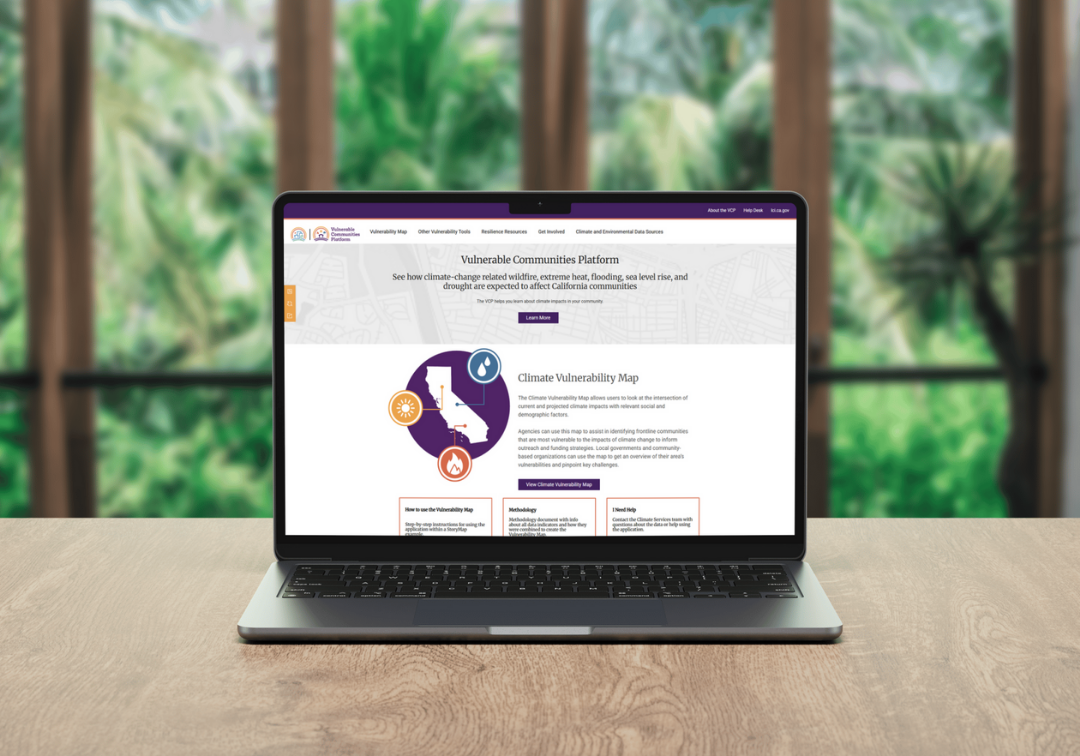What you need to know: The new web-based Vulnerable Communities Platform identifies California communities most sensitive to the impacts of climate change and provides those communities with decision support and guidance on how to prioritize adaptation projects, actions and investments.

SACRAMENTO - Today, California unveiled the Vulnerable Communities Platform (VCP), an interactive web-based tool designed to help Californians understand which worsening climate hazards — such as extreme heat, flooding, sea level rise, drought and wildfire — are most likely to affect their specific communities and how to prepare and adapt.
Developed by the California Governor’s Office of Land Use and Climate Innovation (LCI), the VCP is the first California-specific geospatial tool that combines climate-hazard data with community-vulnerability information. The platform allows users to see how climate change impacts vary across the state — today and into 2050 — and helps local governments, community-based organizations, researchers and residents focus climate adaptation resources and efforts to the communities that need them most.
The tool supports stronger grant applications, guides smarter local investments, and is paired with trainings and technical assistance to ensure users can put the data to work. Built to evolve with new data and feedback, the VCP is designed to stay responsive to California’s most pressing climate challenges.
The VCP offers:
- Climate-hazard and social-vulnerability data at both current and future timeframes (2050 projections).
- Community level insights to support planning, investments and policy decisions related to adaptation and resilience.
- Interactive mapping that highlights where climate hazards and community vulnerabilities overlap.
“From extreme heat and drought to wildfires and flooding, climate change is reshaping every corner of California — but not all communities are affected equally. The Vulnerable Communities Platform brings together the best climate science and social data to show where impacts will be most severe and who is most at risk,” said Abby Edwards, Senior Deputy Director of Planning and Policy at LCI. “More importantly, it’s about action: Helping decision-makers, community leaders and advocates focus resources where they’re needed most. Building a resilient California will take all of us, and this tool is a key step toward that future.”
LCI’s Integrated Climate Adaptation and Resiliency Program (ICARP) is charged with advancing climate equity across the state’s climate adaptation and resilience efforts, and the SB 170 Budget Act of 2021 directed funds to LCI to implement the VCP by June 2026.
The VCP was created through a collaborative process, including more than 25 feedback sessions held over an 18-month period. The process prioritized input from frontline communities and community-based organizations to ensure the platform meets the needs of those most affected by climate change. With this launch, LCI is committed to gathering user feedback and improving the VCP for Version 1.1.
As California continues to build resilience to the impacts of climate change, this Vulnerable Communities Platform will serve as a cornerstone resource that provides transparent, accessible and actionable information to guide adaptation across the state.
Key Features of the first version of the VCP
Climate Vulnerability Map
- Shows areas of low, medium and high vulnerability to extreme heat, sea level rise, flooding, wildfire and drought.
- Includes individual maps for each social, environmental and economic factor in the vulnerability index.
- Generates reports that summarize vulnerability for any city, town, zip code or census tract.
Tool Comparison
- Overlays and compares related tools, such as the Healthy Places Index, Environmental Justice Screen and CalEnviroScreen.
- Gives guidance on what these other tools can do and what their main uses are.
Resilience Resources
- Offers a curated list of climate vulnerability resources, including grants, major policy requirements, state and local planning guidelines, and ways to connect to other community-based organizations and regional collaboratives working on resilience.
VCP Community Pilot
- The VCP team will create a training program to help community-based organizations and local governments develop climate vulnerability assessments using the VCP. An initial group of 10-15 organizations and governments will take part in a series of classes and create assessments for their communities. The process, results and lessons learned will be turned into case studies for future VCP users.
You can sign up to receive updates and share thoughts through the Vulnerable Communities Platform Main Form. If you would like the Vulnerable Communities Platform team to present to your organization or group, please email ClimateServices@lci.ca.gov.
Governor’s Office of Land Use & Climate Innovation
The Governor’s Office of Land Use and Climate Innovation (LCI) oversees and administers programs, policies and initiatives to chart California’s future through bold ideas, proven implementation, and scale inside and outside government. LCI’s leadership is provided by the Director, who is the principal advisor to the Governor in all matters relating to the programs and investments under LCI’s umbrella. LCI also provides ongoing operational support for the California Strategic Growth Council and the California Racial Equity Commission.
The Integrated Climate Adaptation and Resiliency Program (ICARP)
The Integrated Climate Adaptation and Resiliency Program (ICARP) (PRC 71350-71360) drives California’s response to climate impacts, prioritizing equitable approaches that integrate mitigation and adaptation. ICARP’s home within LCI enables the state to coordinate across local, regional and state efforts to support cohesive strategies.

